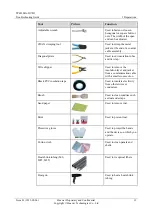
TP48200A-D17B3
Troubleshooting Guide
5 Common Faults
Issue 03 (2013-05-06)
Huawei Proprietary and Confidential
Copyright © Huawei Technologies Co., Ltd
32
5.4 DC Contactor
Table 5-1
Type of the DC contactor
Use Position Type
Checking Method
Battery
protection
branch
Closed type (the contactor is
in the closed state when it is
powered off)
When there is no voltage at the control
poles of the contactor, check whether
the input and output poles of the
contactor are proper by using a
multimeter. For example, the contactor
of the power system is a closed
contactor as shown in Figure 5-1.
When there is no voltage at control
poles 1 and 2 but measuring shows that
input and output poles 3 and 4 are
disconnected, the contactor is faulty.
When there is voltage at the control
poles of the contactor, check whether
the input and output poles of the
contactor are proper by using the
multimeter. For example, the contactor
of the power system is a closed
contactor as shown in Figure 5-1.
When there is voltage at control poles 1
and 2 but measuring shows that input
and output poles 3 and 4 are connected,
the contactor is faulty.
Battery
branch
Open (the contactor is in the
open state when it is
powered off)
When there is no voltage at the control
poles of the contactor, check whether
the input and output poles of the
contactor are proper by using the
multimeter. For example, the contactor
of the power system is an open type
contactor as shown in Figure 5-1.
When there is no voltage at control
poles 1 and 2 but measuring shows that
input and output poles 3 and 4 are
connected, it indicates that the
contactor is faulty.
When there is voltage at the control
poles of the contactor, check whether
the input and output poles of the
contactor are proper by using a
multimeter. For example, the contactor
of the power system is an open
contactor as shown in Figure 5-1.
When there is voltage at control poles 1
and 2 but measuring shows that input
and output poles 3 and 4 are
disconnected, the contactor is faulty.









































